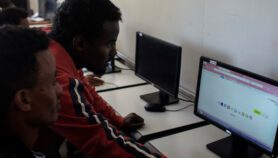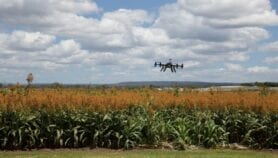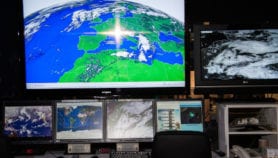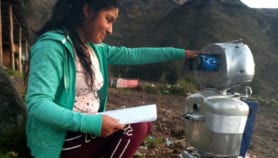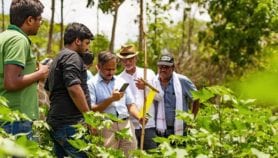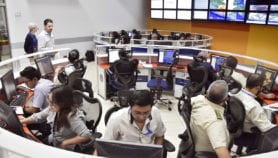Send to a friend
The details you provide on this page will not be used to send unsolicited email, and will not be sold to a 3rd party. See privacy policy.
Co-hosting the world’s largest radio telescope raises South Africa’s scientific standing. But it must also help meet the country’s social needs.
For a country with a relatively modest track record in radio astronomy, South Africa can be proud of being chosen to co-host the planned Square Kilometre Array (SKA), the world’s largest radio telescope, with Australia and New Zealand.
Inevitably, there are those who would have preferred the SKA organising committee, which announced the siting decision last week, to have given the country and its African partners the whole project.
But South Africa’s science minister, Naledi Pandor, showed little disappointment when she declared after the decision: "We have always said that we are ready to host the SKA, and the world has listened to us."
The story, however, is far from over. First, the project — which is expected to cost more than US$2 billion before completion in 2024 — faces a major financial challenge in needing to raise a significant proportion of this money from the international community at a time of worldwide belt-tightening.
Second, South Africa has the equally daunting task of ensuring that the benefits to the country’s high-tech industry will filter down to meet the needs of its poor. There are plenty of sceptics who doubt this will happen; it is up to South Africa to prove them wrong.
Higher costs
The financial challenges are indeed enormous. The money will need to cover not only the physical infrastructure — including 3,000 receiving dishes — but also the vast computing resources that will analyse the data they produce.
Both countries have already planned for substantial investments in prototype facilities — MeerKAT in South Africa and SKA Pathfinder in Australia — which will now be absorbed into the development of SKA.
And South Africa, in particular, has also spent heavily on training researchers and technicians, including the creation of several university professorships. A lack of qualified personnel was initially seen as a major handicap for its bid.
Indeed, one of the stated reasons for choosing a split site was to make maximum use of the money that has already been invested by both countries — a telling indicator of the overall financial pinch that the project is under.
But the overall costs will only increase as a result of the decision to split the site, because advanced computing and data-handling facilities will be needed in both locations.
And the anticipated costs mean that funding from the governments of international partners will be essential — far from easy at a time when public spending across the developed world is already being stretched to breaking point.
Furthermore, the task of raising international funding has been made harder by a decision made last year by US astronomers, that SKA is not among their priorities, which rules out substantial US funding (although some contribution is still expected).
Boost for African science
So it is not surprising that in presentations to European countries — seen as an important potential source of external support — South Africa’s supporters have been highlighting SKA’s potential economic and technical benefits, not just its scientific potential.
The project could certainly bring substantial financial gains to the country, as Bernie Fanaroff, the leader of the South African bid, frequently emphasises. The boost to the country’s information and communications industry alone is likely to be enormous.
There will be less tangible, but no less important, benefits too. SKA, described by one astronomer as potentially signalling "a new dawn for science in Africa", has already become an icon symbolising southern Africa’s ambition to become a key player in the global knowledge economy.
Domestically, it is hoped that the project will spur more schoolchildren to take up science and mathematics — which were deliberately neglected in black educational institutions during the apartheid era.
But the impact needs to go further than that. A major effort will be required to ensure that the benefits are seen to trickle down to the whole community — for example, boosting investment in communications infrastructure at the community level — and that the value of these benefits is widely appreciated.
Down to Earth benefits
South Africa has achieved much in the years since the ending of apartheid in 1990. At the forefront of these achievements has been its ability to develop a world-class scientific community, reflected in its success in attracting 70 per cent of the SKA project.
At the same time, it has failed to make a significant dent in the gap between rich and poor: deep inequalities remain, inevitably stirring political tensions.
SKA can help to bridge these inequalities if it can help raise awareness that science is essential not only for probing the history of the universe, but also for tackling important problems on Earth such as access to clean water or developing renewable sources of energy.
Meeting those needs may be less glamorous, but it is just as challenging as exploring the universe.
And there is a strong link between the two. Many of today’s scientists and engineers in the developed world admit to being inspired to study science by watching astronomy programmes on television, later adapting their enthusiasm to more practical goals.
This link needs to be continually highlighted if, once the initial excitement has worn off, the heavy expenditure on SKA is to continue to receive public support, particularly if the challenge of raising international funding is not adequately met.
Unlocking the secrets of the universe may provide food for the soul. But it is food for the body that remains top priority for many South Africans.
David Dickson
Editor, SciDev.Net



